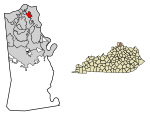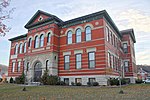James A. Ramage Civil War Museum
The James A. Ramage Civil War Museum sought to tell the untold story of Cincinnati, Ohio, and Northern Kentucky's involvement in the American Civil War. Although no battles occurred there, the people of the area resisted a push by the Confederate army in 1862. The museum was located on the site of Hooper Battery. The museum grounds covered 17 acres (69,000 m2) and it displayed historical passages, stories, and memorabilia. It also paid homage to the Black Brigade of Cincinnati, Fern Storer's kitchen, and the history of the city of Fort Wright. On August 25, 2021, Fort Wright's mayor, Dave Hatter, ordered the museum closed, following a year of negotiations with the museum's board to correct various infrastructure and program problems. Battery Hooper Park, where the museum is located, remains open to the public.
Excerpt from the Wikipedia article James A. Ramage Civil War Museum (License: CC BY-SA 3.0, Authors).James A. Ramage Civil War Museum
Highland Pike,
Geographical coordinates (GPS) Address Nearby Places Show on map
Geographical coordinates (GPS)
| Latitude | Longitude |
|---|---|
| N 39.055555555556 ° | E -84.527222222222 ° |
Address
Highland Pike
41012
Kentucky, United States
Open on Google Maps






